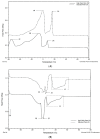Thermomechanical Properties of High Oleic Palm Oil Assessed Using Differential Scanning Calorimetry, Texture Analysis, Microscopy, and Shear Rheology
- PMID: 37888371
- PMCID: PMC10606909
- DOI: 10.3390/gels9100798
Thermomechanical Properties of High Oleic Palm Oil Assessed Using Differential Scanning Calorimetry, Texture Analysis, Microscopy, and Shear Rheology
Abstract
Standard Palm Oil (SPO) is widely used as a food ingredient partially due to its unique thermophysical properties. However, the American Heart Association recommends a saturated fat consumption of <5% of the caloric intake per day. The OxG Palm hybrid yields oil known as "palm oil with a higher content of oleic acid" (HOPO), with <35% SFA and >50% oleic acid. Characterizing novel high oleic oils is the starting point to find processes that can functionalize them such as oleogelation. This study compared the thermophysical properties of HOPO to SPO using Differential Scanning Calorimetry, shear rheology, polarized light microscopy, and texture analysis to characterize the differences between these oils. HOPO had a lower onset crystallization temperature (Δ7 °C) and its rheological behavior followed similar trends to SPO; however, large viscosity offsets were observed and were correlated to differences in crystallization temperatures. The maximum peak force of SPO was an order of magnitude higher than that of HOPO. Overall similar trends between the oils were observed, but differences in firmness, crystal morphology, and viscosity were not linearly correlated with the offset in crystallization temperature. This study quantified differences between these oils that will better enable industry to use HOPO in specific applications.
Keywords: DSC; fatty acid profile; high oleic palm oil; microscopy; rheology; texture.
Conflict of interest statement
The authors declare no conflict of interest.
Figures




References
-
- Nor Aini I., Miskandar M.S. Utilization of palm oil and palm products in shortenings and margarines. Eur. J. Lipid Sci. Technol. 2007;109:422–432. doi: 10.1002/ejlt.200600232. - DOI
-
- Romero H.M., Daza E., Ayala-Díaz I., Ruiz-Romero R. High-Oleic Palm Oil (HOPO) Production from Parthenocarpic Fruits in Oil Palm Interspecific Hybrids Using Naphthalene Acetic Acid. Agronomy. 2021;11:290. doi: 10.3390/agronomy11020290. - DOI
-
- Omar Z., Hishamuddin E., Sahri M.M., Fauzi S.H.M., Dian N.L.H.M., Ramli M.R., Norizzah A.R. Palm oil crystallization: A review. J. Oil Palm Res. 2015;27:97–106.
-
- Sacks F.M., Lichtenstein A.H., Wu J.H.Y., Appel L.J., Creager M.A., Kris-Etherton P.M., Miller M., Rimm E.B., Rudel L.L., Robinson J.G., et al. Dietary fats and cardiovascular disease: A presidential advisory from the American Heart Association. Circulation. 2017;136:e1–e23. doi: 10.1161/CIR.0000000000000510. - DOI - PubMed
LinkOut - more resources
Full Text Sources

